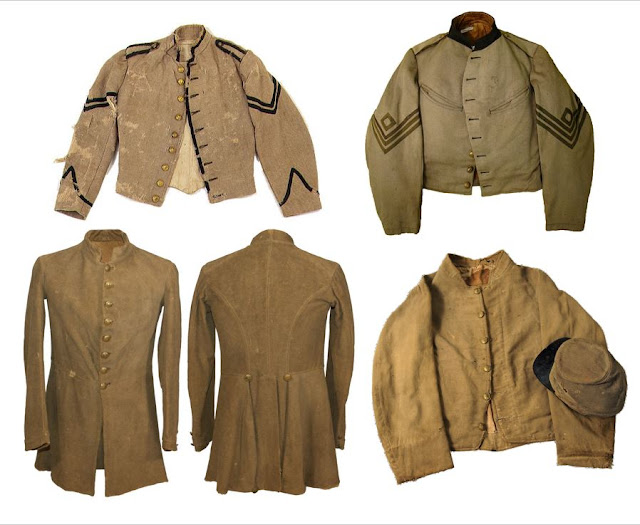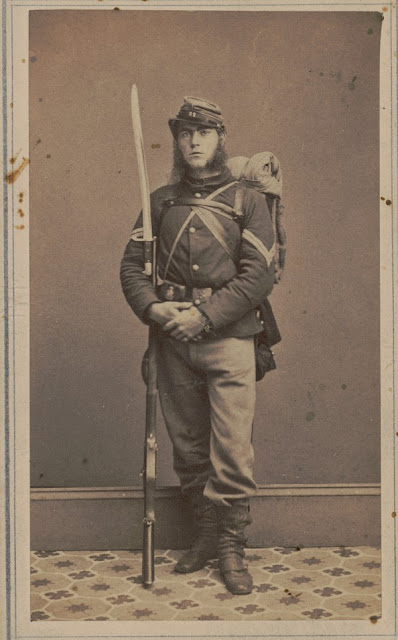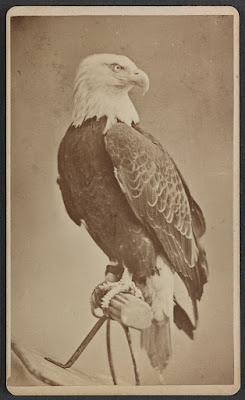The Professor and the Comedienne: A Stones River Love Story
On Thursday, November 5, 1863, Captain Warren Parker Edgarton of Battery E of the 1st Ohio Light Artillery married the widower Julia Daly Olwine in Nashville, Tennessee. It was apparently a quiet wedding- outside of being recorded in the record of Davidson County, Tennessee marriages, no mention was made of the nuptials in any period newspapers. Wartime marriages were hardly uncommon during the Civil War, but the circumstances of how a Massachusetts-born artillery officer from Ohio met one of the most beloved actresses of the American stage is history (quoting the History Guy) that deserves to be remembered.
To start, let’s introduce the couple. Captain Edgarton is a familiar soldier to readers of the blog; the story of how his battery was captured during the opening moments of the Battle of Stones River has been recounted in several previous posts. (See Comanche Versus the Professor, Receipt in Full in Red Ink, An Intimate View of Battery E's Demise, and Captured Entire) The captain was born May 16, 1836, in Harvard, Massachusetts, and by the age of 20 not only was working as a college professor but had published his first book. Moving to Cleveland, Ohio in 1857, he continued his work in education while himself studying law and being admitted to the Cleveland bar in 1859. He gained an enviable reputation for his powerful oratory and a bright future as an attorney and educator beckoned. Then the war came.
 |
| The couple: actress and comedienne Julia Daly and Captain Warren Parker Edgarton. |
Within days of the firing upon
Fort Sumter, Edgarton joined the Cleveland Light Artillery as a private and saw
action in the first “battle” of the Civil War at Philippi, Virginia in June.
Upon returning from his 90-days’ service, Edgarton received a commission from Governor
William Dennison to raise his own artillery battery. That battery became
Battery E of the 1st Ohio Light Artillery and by the end of 1861, it
was learning the ways of war among the hills of central Kentucky as part of
General Don Carlos Buell’s Army of Ohio.
While Captain Edgarton drilled his men in Kentucky, Julia Daly won plaudits in city after city for her comedic
talents and ability to command the stage like few others. Born in Pennsylvania
in 1837, Julia made her stage debut in 1855 and quickly developed a wide
following as she toured the Northeast. She
starred in a number of productions: as Caroline in Our Gal, as Biddy in Irish
Girl in America, but perhaps most famously as Pamelia Appleby in Our
Female American Cousin. In another piece entitled In and Out of Place,
Julia played upwards of 6 roles! Labeled as “lively and vivacious comedienne,” Julia
took her act across the ocean and made a big splash on the stages of Great
Britain and Scotland during the 1860 and 1861 seasons.
The winter of 1862 found her
back in the states and as her future husband and his battery prepared to move
south against Nashville in February 1862, Julia completed a highly successful
stand in Louisville, Kentucky. “We have never had an actress come among us so
comparatively unheralded and yet achieve so great a hold upon the public favor
from her very first appearance as Miss Julia Daly has done,” opined the Louisville
Daily Courier. “We have surrendered at discretion and confess that she is
the very queen of the comic stage in spite of the parade of pretenders who
would arrogate that title. Her fun is infectious; she can be laughable without
overstepping the modesty of nature. She can sing beautifully and her acting is
so thoroughly artistic. In fact, she never forgets that she is a lady performing
to a refined and intelligent audience.”
In the meantime, Captain
Edgarton developed his reputation as one of the best artillery commanders in
the Army of Ohio. The “professor” put on a clinic on the evening of December
30, 1862, as he deftly maneuvered his full battery into opening a surprise fire
upon Captain Felix Robertson’s battery, battering Robertson so thoroughly that
the Texan quickly withdrew. Despite this signal success, Captain Edgarton was
unable to persuade his brigade and division commanders to allow him to relocate
his battery (and the other two batteries of the division) to good defensive ground
north along Gresham Lane. It doomed his battery to destruction the following
morning.
Around 6:20 a.m. on December 31,
1862, General John P. McCown’s Confederate division launched their dawn assault
on the Union right in the opening thrust of what became the Battle of Stones
River. Edgarton’s battery, positioned near the intersection of Gresham Lane
with the Franklin Pike, took the brunt of that initial assault spearheaded by
the General Mathew D. Ector’s dismounted Texas cavalrymen. Edgarton’s gunners
managed to fire upwards of 20 rounds before being swiftly overwhelmed by Ector’s
brigade.
Adjutant Samuel Davis of the 77th Pennsylvania witnessed Edgarton’s last moments on the battlefield that morning, watching breathlessly as Edgarton “grimly stood by one of his pieces and assisted by Lieutenant Berwick, loaded, and discharged it into the living column as it closed upon him, mowing a huge road through it and in an instant after he was wounded. Many of his men refused to leave him and fought the foe with their swabs and were killed or captured.” Edgarton himself was shot in the groin by a spent ball, and stumbling around one his guns, received two more wounds in the arm as he fell across the trail of the piece and was captured. He later said, “I lost my guns, but I took the enemy’s receipt in full in red ink.”
Captain Edgarton was among the
38 captured Federal officers (including Brigadier General August Willich who
was captured mere moments after Edgarton) sent south as prisoners after the
battle. Passing through Chattanooga on January 3rd, the men were deposited
in Atlanta and stayed for the better part of a month. In February, a group of
them were sent to Libby Prison in Richmond, Virginia where they would remain
until exchanged in early May 1863. Edgarton received his exchange order on May
8, 1863, a few days after the Battle of Chancellorsville, and arrived back in Cleveland
on May 12th. Here is where a bit of supremely fortuitous timing
brought the professor and the comedienne together.
Clevelanders were eager to hear
of Captain Edgarton’s novel experiences not only in the Battle of Stones River
but of life in “Dixie,” and he accommodated their desires by embarking on a
speaking tour. Before the war, Edgarton frequently provided oratory at the
Cleveland Academy of Music and he gave several talks there during this speaking tour. It
just so happened that on Monday night, May 18, 1863, Julia Daly performed her
first of six nights in Cleveland at the same Academy of Music, starring as
Pamelia in Our Female American Cousin. It was during this 6-day engagement that
I believe that Captain Edgarton and Julia met.
Now it is worth noting that at
the time, Julia was a recent widower. Before the war, she had married noted
Philadelphia attorney Isaac Wayne Olwine. Olwine was a gifted public speaker
and author, like Edgarton, and had published a book about legal matters in the
1850s before devoting himself fully to theatrical affairs. “He made no
particular mark as an actor, but became well known as a business agent, traveling
agent, and subsequently stage manager of various theaters,” his obituary
stated. Upon marrying Julia, Isaac “traveled with her on professional tours
throughout the United States and Great Britain. He devoted much of his time to
dramatizing works and has been agent abroad for some of the most popular pieces
performed in this country,” his obituary noted. He died of consumption in
Philadelphia on December 13, 1862, the same day as the Battle of Fredericksburg,
leaving the entirety of his substantial estate to his wife Julia.
One can only speculate exactly how
these two met, but the romance moved swiftly.
Julia completed her engagement in Cleveland by late May, and likewise Captain
Edgarton moved back to the rejoin the Army of the Cumberland at roughly the same
time. There had been some changes made while he was gone; Battery E now was
assigned to the Post of Nashville and Edgarton found himself publicly criticized
by the commanding general William R. Rosecrans who called out Edgarton in his
official report of the Battle of Stones River.
“Captain Edgarton was guilty of
a grave error of taking even a part of his battery horses to water at an
unreasonable hour and thereby losing his guns,” Rosecrans chided. As I argue in
“Receipt in Full in Red Ink,” I think Rosey’s charges were hogwash and struck
me as more an attempt to cover up for General Richard W. Johnson, a fellow West
Pointer whose mistakes in deploying his division led to the disaster. It is
worth noting that Rosecrans specifically requested Johnson to rejoin the army
in December after Johnson was captured near Gallatin, Tennessee in August. Johnson
displaced the popular General Joshua Sill in command of the second division and
Sill would lose his life bravely fighting his brigade during Stones River; that
said, Rosey had a vested interest in protecting Johnson’s reputation from criticism.
Not unsurprisingly, Edgarton took exception to Rosecrans’ charge, hotly
defending his record in his own after-action report that he wrote from
Nashville on June 25. “As I have been charged with grave errors on the occasion
of the battle, I respectfully request that I may be ordered before a court of
inquiry that my conduct may be investigated, Edgarton concluded.
He never got it. Rosecrans’ focus
was now on pushing the Confederates out of middle Tennessee and invading
Georgia. Rehashing events from six months ago took a backseat to the
overarching object of combatting Braxton Bragg’s Army of Tennessee. Denied a
chance to clear his name and left in the backwash of war, Edgarton and his
battery remained in Nashville until early September when they were finally
ordered forward, taking post at Stevenson and then Anderson’s Crossroads,
protecting Rosey’s supply lines but not rejoining the main army.
 |
| Advertisement in the November 10, 1863, Nashville Daily Union publicizing Julia Daly's stint at the New Theater located at Union and Summer streets in downtown Nashville. |
One is left to wonder the exactly
how, but Captain Edgarton secured a brief leave of command to travel back to
Nashville where on November 5, 1863, he married Julia Daly Olwine. Their time
together must have been brief- Julia opened a series of engagements at the New
Theater in Nashville on November 9th and as for Captain Edgarton,
with Rosecrans now relieved from command after Chickamauga, he was summoned back
to the army by General Phil Sheridan who made him chief of artillery. Edgarton commanded
the guns at Fort Negley in Chattanooga and then played a role in the Federal
victory at Missionary Ridge. “Stationing two regular batteries on Orchard Knob,
he directed their fire on the enemy until our own troops came in range, then
mounted his horse and dashed to the front, joining General Sheridan just in
time to participate in the capture of Bragg’s headquarters,” a later biography
of Edgarton noted.
The couple would enjoy 23 years marriage,
a time where the couple traveled extensively in Canada, Europe, and throughout the
American Midwest. Julia continued on the stage until giving her final European
tour from 1870-1871. Captain Edgarton soon after joined the Post Department and
went on to a notable career as one of the best postal inspectors in the service.
Warren and Julia eventually
settled in rural New Jersey on a farm they called Villa Rosello near Newfield. She passed away August 21, 1887, at the couple’s
home, ending one of the most remarkable wartime romances that I’ve ever come
across.
Life is full of what ifs but in
this case, had it not been for the fact that he was captured at Stones River, I
doubt that Captain Edgarton would ever have had the opportunity to meet Julia
that day in Cleveland in May 1863. That said, one could argue that the Battle
of Stones River introduced Captain Warren Parker Edgarton to his wife.
I hope you’ve enjoyed taking the
journey with me.












Comments
Post a Comment